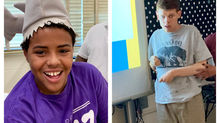The Impact of Anxiety in Autistic Individuals
- Ingrid Ventura Ellis
- Jun 29, 2023
- 2 min read

It wasn’t until I started working with spellers that some of their vivid struggles were communicated with words in addition to their body’s physical responses.
As Matthew Seigel, Director of the Developmental Disorders Program of Spring Harbor Hospital in Maine suggests, the challenge increases when the individual is less communicative. Yet, some spellers still struggle to identify and understand their own emotions and anxiety.
As a teacher, job coach, and family consultant, I recognized that my students’ “anxiety” manifested in different ways: Eloping, aggression, self-injurious behaviors (SIBs), destruction, crying, laughing, isolation, repetitive rituals, etc.
Their struggles and distress were caused by many different triggers, some of them clear, others not so much: Change in routines, sensory overload, illness, hunger, expectations, phobias, lack of or incorrect support, etc. The reality is that anxiety can take different overwhelming forms to different people (Fein, E. 2019).
Professionals and families often question the reason why anxiety and autism occurs at a high frequency. Could it be genetics, traumas, fears, day to day unpredictability, life experiences/challenges? As a professional, my focus is to learn how to assist and alleviate some of this anxiety when supporting my students.
This is well described by Nick: “To take control back alone is frankly impossible. I rely on someone supporting me to act as the thinker and holder of strategies”.
Listening and becoming aware of my student’s needs is a first step in assisting them.
We have learned so much together from these challenges and have created different adaptations to the environments. However, the chaos, disorientation, or disorganized experience takes time, caring, and attention. What works for one person, might not work for another.

As Nadia, a young speller, emphasizes, “The first part of intentionally opening your listening senses is the single most important thing that you can do to help your student”. (Communication for Education, Module15).
A good point is the creation of “social spaces” that are more accommodating to these needs (Fein, Elizabeth, 2017). However, those spaces are not readily available. It is then that caregivers and teachers find the need to come up with some other approaches.
The use of routines can help with predictability, mindfulness practice can help with frustration, careful pharmacological interventions can address some symptoms.
Different versions of Cognitive Behavior Therapy can maintain focused goals. (Wood JJ, et al. 2019).
The bottom line is that using multiple systems is a model that opens the opportunity to learn and find better systems to deal with our student's anxiety. Having more empathy and acceptance builds up a trust that can definitely make things better in this process.
Want to read more about anxiety directly from #actuallyautistic people?
Sources:
Jacob Brogan, J.(Host). (2017, October 11).Spectrum Stories: The overlap between autism and anxiety (No. 7). In Spectrum stories. https://www.spectrumnews.org/features/multimedia/podcasts/spectrum-stories/spectrum -stories-overlap-autism-anxiety/
Communication for Education, Module 15. https://www.communicationforeducation.com/
Wood JJ, Drahota A, Sze K, Har K, Chiu A, Langer DA. Cognitive behavioral therapy for anxiety in children with autism spectrum disorders: a randomized, controlled trial. J Child Psychol Psychiatry. 2009 Mar;50(3):224-34. doi: 10.1111/j.1469-7610.2008.01948.x. PMID: 19309326; PMCID: PMC4231198.
* Additional writings from Nick Barry: https://neuroclastic.com/?s=nick+barry


























.png)

.png)



.png)


Comments